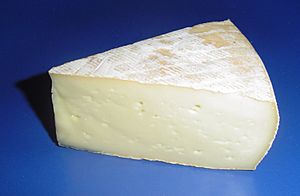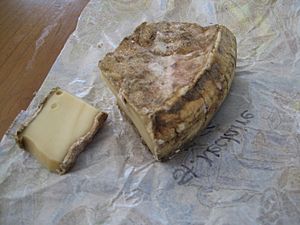Saint-Nectaire facts for kids
Quick facts for kids Saint-Nectaire |
|
|---|---|
 |
|
| Country of origin | France |
| Region, town | Auvergne, Saint Nectaire |
| Source of milk | Cow |
| Pasteurised | Depends on variety |
| Texture | Semi-soft washed rind |
| Aging time | 8 weeks |
| Certification | French AOC 1955 |
| Named after | Lua error in Module:Wikidata at line 70: attempt to index field 'wikibase' (a nil value). |
Saint-Nectaire is a delicious French cheese. It comes from the Auvergne region in central France. People have been making this special cheese there since at least the 1600s!
Contents
- History of Saint-Nectaire Cheese
- What Saint-Nectaire Cheese Looks Like
- Where Saint-Nectaire Cheese is Made
- Special Rules for Saint-Nectaire
- How Saint-Nectaire Cheese is Made
- How Much Saint-Nectaire is Made
- How to Enjoy Saint-Nectaire
- Visit the House of Saint-Nectaire
- Fun Facts About Saint-Nectaire
- See also
History of Saint-Nectaire Cheese
For a long time, Saint-Nectaire cheese was made mostly on farms. Women often made it. It was even called "rye cheese" because it was aged on rye straw. This cheese is famous for being creamy and having a hazelnut taste.
A French marshal named Henri de La Ferté-Senneterre introduced it to King Louis XIV's court. The king loved it right away! By 1768, many people knew about it. A traveler wrote that if you were invited to a feast, Saint-Nectaire cheese would always be there. Marshal Senneterre also helped make Cantal and Salers cheeses famous.
What Saint-Nectaire Cheese Looks Like
This cheese is made from cow's milk. The cows are usually Holstein, Montbéliarde, or sometimes Salers breeds. It's shaped like a cylinder.
A regular Saint-Nectaire cheese is about 20 to 24 centimeters (8 to 9.5 inches) wide. It is about 3 to 5 centimeters (1 to 2 inches) thick. It never weighs more than 1.85 kilograms (about 4 pounds).
There's also a smaller version called "petit-Saint-Nectaire." It's about 12 to 14 centimeters (4.7 to 5.5 inches) wide. It's 3.5 to 4.5 centimeters (1.4 to 1.8 inches) thick. This smaller cheese weighs no more than 0.65 kilograms (about 1.4 pounds).
The cheese has a special rind (the outside skin). It can be white, brown, or gray. It might have orange, yellow, or red spots. If the rind is all one color, it can't be sold as Saint-Nectaire. When you cut it, the inside is soft and creamy. It smells a bit and has a hazelnut flavor. This flavor comes from the special plants where the cheese ages.
Where Saint-Nectaire Cheese is Made
This cheese is made in a special area in France. It's a grassy, volcanic region called the Pays des Monts-Dore. Only 72 villages are allowed to produce Saint-Nectaire. Most of these villages (52 of them) are in Puy-de-Dome. This includes the village of Saint-Nectaire itself. The other 20 villages are in Cantal.
Special Rules for Saint-Nectaire
Saint-Nectaire has a special certification called Appellation d'origine contrôlée (AOC). This means it has to follow strict rules to be called Saint-Nectaire. For example, it must be made from cow's milk. It also has to be made in a specific area in the Monts-Dore region. This AOC status was first given in 1955.
When the AOC started, Saint-Nectaire was only made on farms. But then, factories were also allowed to make it. To tell them apart, farm-made cheeses have a small green oval label. Factory-made cheeses have a square label. In 1996, Saint-Nectaire also got a Protected Designation of Origin (PDO). This protects its name all over the European Union. The "petit-Saint-Nectaire" (small Saint-Nectaire) was also added to these rules later.
How Saint-Nectaire Cheese is Made
Farm-made Saint-Nectaire uses fresh, unpasteurized milk. It's made twice a day, right after the cows are milked. Factory-made Saint-Nectaire can use different kinds of milk. It can also use milk that has been heated (pasteurized). It takes about 13 to 14 liters (3.4 to 3.7 gallons) of milk to make one cheese.
First, a special ingredient called rennet is added to the milk. This makes the milk curdle, like turning into soft lumps. This takes about 30 to 40 minutes. Then, the curds are broken up into tiny pieces, about the size of wheat grains. This is done with a tool called a lyre.
Next, the cheese makers collect these small curd pieces. The liquid part, called whey, is drained away. The whey makes up 80% of the original milk! Sometimes, this whey is given back to the cows. It can also be used by other companies to make things like chocolate or food for calves.
After draining, the curd pieces are pressed into a mold for the first time. This pressed cheese is called a tome. The tome is then wrapped in linen. A small label (oval for farm-made, square for factory-made) is put on it. The cheese is also salted. Then, it's put into a press for 12 to 24 hours. After this, the cheese is unwrapped and stored in a cool room. It stays there at about 10 degrees Celsius (50 degrees Fahrenheit).
The next step is called affinage, or maturing. This is when the cheese gets its special flavor and texture. It must age for at least 28 days. The smaller "petit-Saint-Nectaire" ages for at least 21 days. Farm-made cheeses usually age for five to six weeks. Some can age for two or three months. During this time, the cheeses are washed many times with salty water. They are also turned over regularly. This helps them get their unique orange-gray rind.
The cheeses are aged on rye straw. Most Saint-Nectaire cheeses are sent to experts called affineurs. These experts finish the aging process for the last six weeks. If the cheese isn't developing enough flavor, the aging process might be stopped early.
How Much Saint-Nectaire is Made
Saint-Nectaire is the most produced farm-made cheese with an AOC in France. About 6,500 tons are made each year by 240 farmers. Factories also produce a lot, about 7,000 tons. In 2007, a total of 13,500 tons of Saint-Nectaire cheese were made!
How to Enjoy Saint-Nectaire
This cheese can be eaten with any meal. You can also use it in tarts, pies, and buns.
Visit the House of Saint-Nectaire
If you want to learn more, you can visit "La Maison du Saint-Nectaire." This means "The House of Saint-Nectaire." It's a museum in the village of Saint-Nectaire. It shows the history of the cheese and how it's made.
Fun Facts About Saint-Nectaire
The cheese got its name from the Marshal of Senneterre. He was the one who served it to King Louis XIV. The marshal's name was a bit like "Saint-Nectaire."
See also
 In Spanish: Saint-Nectaire (queso) para niños
In Spanish: Saint-Nectaire (queso) para niños




